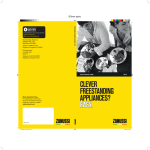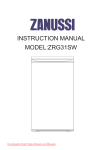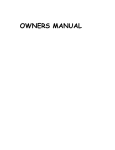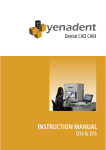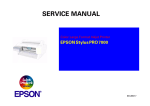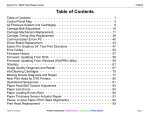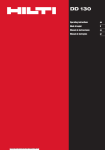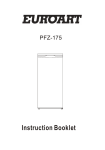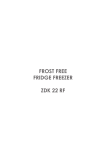Download ZFG06400WA Freezer EN
Transcript
N Freezer ZFG06400WA Contents Contents ......................................................2 Important safety instructions .......................3 Installation ...................................................3 Child safety .................................................3 During use ...................................................3 Maintenance and cleaning ..........................3 Servicing ......................................................3 Description of the appliance ........................4 Control unit ..................................................4 Using the appliance .....................................4 Before use ...................................................4 To Start the appliance ..................................5 Thermostat control ......................................5 The freezer compartment ..........................5 Freezing fresh food .....................................5 Frozen food storage ...................................5 Tips ..............................................................5 2 EN HR 2 Hints and tips ..............................................6 Normal operating sounds ...........................6 Food storage ...............................................6 Energy saving advice ..................................6 In the event of a power failure ...................6 Maintenance and cleaning ..........................7 Internal cleaning .........................................7 External cleaning ........................................7 When the appliance is not in use ...............7 What happens if something goes wrong ......8 Installation instructions ................................9 Installation requirements ............................9 Ventilation requirements .............................9 Door reversibility .......................................10 Warning! ....................................................10 Electrical connection..................................11 www.zanussi.com Important safety instructions These warnings are provided in the interests of your safety. Ensure that you understand them all before installing or using this appliance. Your safety is of paramount importance. If you are unsure about any of the meanings or these warnings contact the service centre. Installation This appliance is heavy. Care should be taken when moving it. It is dangerous to alter product in any way. Ensure that the appliance does not stand on the electrical supply cable. If the supply cord is damaged, it must be replaced by an original power cable supplied by the service centre by calling the 1800 number supplied in the warranty section of this manual. Any electrical work required to install this appliance should be carried person. Parts, which heat up, should not be exposed. Whenever possible, the back of the appliance should be close to a wallbut leaving the required distance for ventilation as stated in the installation instructions. The appliance should be left for 2 hours after installation before it is turned on, in order to allow the refrigerant to settle. WARNING-Keep ventilation openings, in the appliance enclosure or in the build-in structure, clear of obstruction. WARNING-Do not use mechanical devices or other means to accelerate the defrosting process, other than those recommended by the manufacturer. WARNING-Do not damage the refrigerant circuit. WARNING- If the supply cord is damaged, it must be replaced by the manufacturer or its in order to avoid a hazard. WARNING- Do not use electrical appliances inside the food storage compartments of the appliance, unless they are of the type www.zanussi.com recommended by the manufacturer. WARNINGwhen maintaining the refrigerator as the refrigerant and vesicant are burnable. Useless and old refrigerators should be recycled and disposed by professional companies. WARNING-Do not discard useless and old refrigerators at will in order to avoid environment pollution. Thank you for your cooperation. Child safety Do not allow children to tamper with the controls or play with the product. During use This appliance is designed for domestic edible foodstuffs only. Frozen food should not be refrozen once it has thawed out. in the freezer. Ice lollies can cause "frost/ freezer burns" if consumed straight from the freezer. Do not remove items from the freezer if your hands are damp/wet, as this could cause skin abrasions or frost/freezer burns. Manufacturer recommended storage times should be adhered to. Refer to relevant instructions. Maintenance and cleaning Switch off, and unplug the appliance before carrying out any cleaning or maintenance work. Do not use sharp instruments to scrape off frost or ice. (See defrosting instructions). Servicing This product should be serviced by an authorised engineer, and only genuine spare parts should be used. Under no circumstances should you attempt to repair the machine yourself. Repairs carried out by inexperienced persons may cause injury or 3 HR3 EN serious malfunctioning. Contact your local Service Force Centre. Please read this instruction book carefully before use and retain for future reference. Please read this instruction book carefully before use and retain for future reference. IMPORTANT: before you install your refrigerator PLEASE CHECK FOR ANY refrigerator is damaged or marked you must report this within 7 days if you wish to claim for the damaged marks under the manufactures warranty. This does not affect your statutory rights. Description of the appliance Using the appliance Control Unit This appliance is designed for domestic use Storage Backets Door Control unit MAX NORMAL HR EN 4 4 MIN foodstuff. This appliance is designed to operate in ambient temperatures (surrounding air temperature) between 16°C and 38°C. If these temperatures are exceeded i.e., colder or warmer, the appliance will not operate correctly. Should the ambient temperatures be exceeded for long periods, the temperature in the freezer compartment will rise above -18°C and food spoilage may occur. Before use Remove all securing tapes. Wash the inside of the appliance with lukewarm water with a little bicarbonate of soda added (5ml to 0.5 litre of water). Do not use soap or detergent as the smell may linger. Dry the appliance thoroughly. www.zanussi.com To Start the appliance Freezing fresh food 1. Allow the appliance to stand for 2 hours after installation. 2. Plug in the appliance and switch on at the mains supply. 3. Turn the thermostat control to the required setting. A midway setting is usually suitable for normal operation (see thermostat control). 4. Leave the appliance for approximately 4 hours for the correct temperature to be reached before placing food inside. Place the fresh food on the top freezer shelf. Food may need rearranging to achieve this. During the freezing process the temperature of fresh food should be reduced quickly so that ice crystals are kept as small as possible to prevent damaging the structure of food. If freezing takes place slowly large ice crystals form and these will affect the quality of food once it has defrosted. Thermostat control The thermostat control situated in the control panel regulates the temperature of the freezer compartment. ● Position "Min" -Cold. ● Position "Normal" -Colder.normally, setting at this position. ● Position "Max" -Coldest. The temperature will be affected by: ● Room temperature ● How often the door is opened ● How much food is stored ● Position of the appliance In determining the correct temperature control setting, all these factors have to be considered and some experimentation may be necessary. Do not allow children to tamper with the controls or play with the product. The freezer compartment The symbol means that your freezer will store frozen food at -18°C (-0.4 ° F) or colder allowing for long term frozen food storage and freezing of fresh food. The freezer temperature is controlled automatically by the thermostat situated in the control panel. Due to the different installations, methods of usage and weather conditions, adjustments to the temperature settings may be required. These are best assessed against a temperature reading on a thermometer buried in the frozen food. The reading must be taken quickly as the thermometer temperature will rise rapidly after removal. www.zanussi.com Frozen food storage The appliance has the following net storage volume: 68 litres. This is a standard measurement and the actual capacity depends upon the density and sizes of the food. Pre-packed commercially frozen food should be stored in accordance with the manufacturer's instructions for a 4 star frozen food compartment and should be put in the freezer as soon as possible after purchase. Your freezer provides for long term storage which generally means up to 3 months but the length of the time can vary and it is important to follow the recommended times shown on packets of commercially frozen food. Do not place sealed containers or carbonated liquids creates pressure on the container which may cause it to explode resulting to damage to the freezer. Ice cubes and ice lollies should not be consumed immediately after removal from the freezer as it may result in low temperature skin abrasions. Manufacturers storage times should be adhered to. Tips Any opened packets of frozen food, should be rewrapped in airtight materials to prevent surface evaporation which causes drying or "freezer burn" . Frozen food which is allowed to thaw accidentally should either be used immediately or thrown away. Alternatively if the food is uncooked and has not been aim to check dates on packets and rotate than textures begin to change. 5 HR 5 EN Hints and tips Normal operating sounds You may hear faint gurgling or bubbling sounds when the refrigerant is pumped through the coils or tubing at the rear, to the shelves. When the compressor is on, the refrigerant is being pumped round, and you will hear a whirring sound or pulsating noise from the compressor. A thermostat controls the compressor, and thermostat cuts in and out. Food storage When you arrive home, place the frozen food in the freezer immediately. Keep the time between buying chilled food and placing it in your fridge as short as possible. Do not push food together too much; try to allow air to circulate around each item. Do not store food uncovered. Ensure that food placed in the freezer is dated and labeled and used in date order to ensure that food is consumed at its best. Remove suspect food from your refrigerator and clean, refer to cleaning and maintenance. Energy saving advice Do not install the appliance close to sources of heat, such as a cooker, dishwasher or radiator. Locate the appliance in a cool wellventilated room and make sure that the air openings is good. Avoid unnecessary frosting in the cabinet by packing all foodstuffs into airtight packages. Always leave warm food to cool down in room freezer. Food which is to be frozen (when cool) HR EN 6 6 should be placed in the fridge before being transferred to the freezer. Thaw frozen food in the fridge. This will ensure safer defrosting of food and reduce the work of the refrigeration unit. Try to avoid keeping the door open for long time, warm air will enter the cabinet, and cause energy consumption. Ensure there are no obstructions preventing the door from closing properly. It is advisable to periodically clean the freezer. In the event of a power failure If there is a power failure during the storage of frozen food, keep the door closed. If the temperature within your freezer should rise, do not refreeze the food without checking its condition. The following guidelines should assist you: ● Ice cream :Once thawed should be discarded. ● Fruit and vegetables: If soft should be cooked and used up. ● Bread and cakes: Can be refrozen without danger. ● up quickly. ● Cooked dishes: i.e. casseroles, should be refrigerated and used up. ● Large pieces of meat: Can be re-frozen providing there are ice crystals remaining within them. ● Small joints: Should be cooked and then re-frozen as cooked dishes. ● Chicken: Should be cooked and re-frozen as a fresh dish www.zanussi.com Maintenance and cleaning Before any maintenance or cleaning work is carried out, DISCONNECT the appliance from the ELECTRICITY supply. Internal cleaning Clean the inside and accessories with warm water and bicarbonate of soda (5ml to 0.5 litre of water). Rinse and dry thoroughly. Do not use detergents, abrasive powders, highly perfumed cleaning products, wax polishes or cleaning products containing bleach or alcohol. External cleaning Wash the outer cabinet with warm soapy water. Do NOT use abrasive products. There are sharp edges on the underside of the product, so care should be taken when cleaning. Once or twice a year dust the compressor at the back of the appliance, with a brush or vacuum cleaner, as an accumulation of dust will affect the performance of the appliance and cause excessive electricity consumption. To Defrost the Freezer www.zanussi.com 1. Wrap any food in layers of newspaper or blankets. 2. Switch the appliance off at the wall socket and remove the plug. 3. Open the freezer door. 4. Place a suitable container to collect the defrosting water. 5. After defrosting, clean and dry the interior. 6. Switch the appliance on and replace any frozen food. Defrosting can be speeded up by putting bowls of hot (not boiling) water in the freezer and loosening the frost with a suitable plastic scraper. If the temperature of frozen food is allowed to rise during defrosting, its storage life may be shortened. When the appliance is not in use When the appliance is not in use for long periods, disconnect from the electricity supply, empty all of the food and clean the appliance, leaving the door ajar to prevent unpleasant smells. 7 HR EN 7 What happens if something goes wrong BEFORE contacting your local service force centre, check the following points: Symptom Solution Check there is power at the socket. Check there is not a power cut by checking the household lights. Check the fuse has not blown. Check the thermostat is turned to correct appliance operating limits of 16°C to 32 °C. Relocate the appliance if necessary. The temperature Has door just been open? in the freezer section is too Is so leave for a few minutes to allow the air pressure to equalize. high. The compressor runs continuously. Large quantities of food have recently been placed in the cabinet/and or door is frequently open. Ensure that the door is not left open. Excessive frost Check that nothing is preventing the door from closing. and ice have Is the door gasket intact and clean. built up. Has advised periodic defrosting been carried out? Refer to normal operating sounds. If after the above checks there is still a fault call your local Service Force Centre. In-guarantee customers should ensure that the above checks have been made as the engineer will make a charge if the fault is not a mechanical or electrical breakdown. Please note that proof of purchase is required for inNoise guarantee service calls. Check the thermostat is turned to the correct setting relative to ambient conditions. Check the ambient temperature is within the controllers. The compressor runs continuously. Adjust the thermostat to give correct temperature. Nema napajanja uređaja. HR EN 8 8 www.zanussi.com Installation instructions attempt to modify this product in any way. Installation requirements To ensure correct operation this appliance must not be located where the temperatures will fall below 16 °C or rise above 32 °C. Avoid the following locations: unheated kitchen, outhouse, conservatory, garage. For correct operation this appliance must be installed: ● In a dry atmosphere. ● Out of direct sunlight. ● Away from extreme temperature (not next to a cooker or other sources of heat). Your appliance will be heavy when loaded with food and must therefore be stood on a Ventilation requirements Gently push into place until the top panel rear www.zanussi.com ventilation grille touches against the wall. When in position a 50 mm (2" ) clear space above the appliance should be maintained. If space above the appliance is not available, clearance of 25mm should be maintained on both sides. Ensure that the appliance does not stand on the electrical supply cable. Parts which heat up should not be exposed. Whenever possible, the back of the appliance should be close to a wall but leaving the required distance for ventilation. Leveling: The appliance should be level. Rocking: Ensure the appliance is upright and Adjust the level by screwing out the appropriate level adjuster at the front, (use This appliance is heavy. Care should be taken when moving it. 9 HR EN 9 Door reversibility The side at which the door opens can be changed from the left side to the right side (as supplied), if the installation site requires. Warning! When changing the side at which the door opens, the appliance must not be connected to the mains. Remove plug from the mains beforehand. 11 10 7 9 8 1. 2. 3. 4. 5. 6. 7. 8. 9. 10. 11. Screw Low Hinge Upper Hinge Adjustable Low Foot Adjustable High Foot Screw Bolt Plug Decoration Block The block of the top cover Top Cover Plate Screw nail 1. Remove the screw nails (11). 2. Keep the door open, raise the end of the 10 10 HR EN top cover, push it(10) frontad and take it off from the block(9) of the top cover, then move the bottom block(8). 3. Remove the two screws blot (6) that connect the upper hinge (5) on the right side of the cabinet top. 4. Carefully lift the door and place it on a padded surface to prevent scratching. 5. Remove the plug (7) and transfer it to the uncovered hole on the right side of the into the hole. 6. Remove the two screws(6) that hold the lower hinge (2) on the right side of the unit. 7. Remove the screw-type leveling front leg (4) and transfer it to the right side as 8. Set the door into it's new place making sure the pin enters the bushing at the lower frame section (hole). 9. Secure the upper hinge (5) previously removed in step 3 on the left side of the unit. Make sure the pin enters the bushing on the upper frame section (hole). 10. Loosely secure the lower left hinge (2) and do not tighten the bolts until the door is in the closed position and leveled. 11. Insert the plug (7) on the uncovered holes (right side). 12. Fix the decoration block(8)in the right of the top cover plate(10). 13. Keep the door open, raise the end of the top cover, pull it(10) backwards to hitch the block(9). 14. After the assembly of the top cover, close screw(11). www.zanussi.com Electrical connection Caution! Any electrical work required to install this appliance should be carried out by a qualified electrician or competent person. Warning! This appliance must be earthed. 2 3 5 4 Important! The wires in the mains lead are colored in accordance with the following code 1 Green and Yellow: Earth 3 Brown: Live 5 Blue: Neutral As the colours of the wires in the mains lead of this appliance may not correspond with the coloured markings identifying the terminals in your plug, proceed as follows: www.zanussi.com 1. Connect the wire coloured green and yellow to the terminal marked either with the letter "E" or by the earth symbol or coloured green and yellow. 2. Connect the wire coloured blue to the termi-nal either marked with the letter "N" or col-oured black. 3. Connect the wire coloured brown to the ter-minal either marked with the "L" or colour-ed red. 4. Check that no cut, or stray strands of wire is present and the cord clamp is secure over the outer sheath. 5. Make sure the electricity supply voltage is the same as that indicated on the appliance rating plate. 6. Switch on the appliance. The appliance is supplied with a 13 amp plug fitted . In the event of having to change the fuse in the plug supplied, a 13 amp ASTA approved (BS 1362) fuse must be used. Warning! A cut off plug inserted into a 13 amp socket is a serious safety 11 HR EN 11 502012 www.zanussi.com/shop












